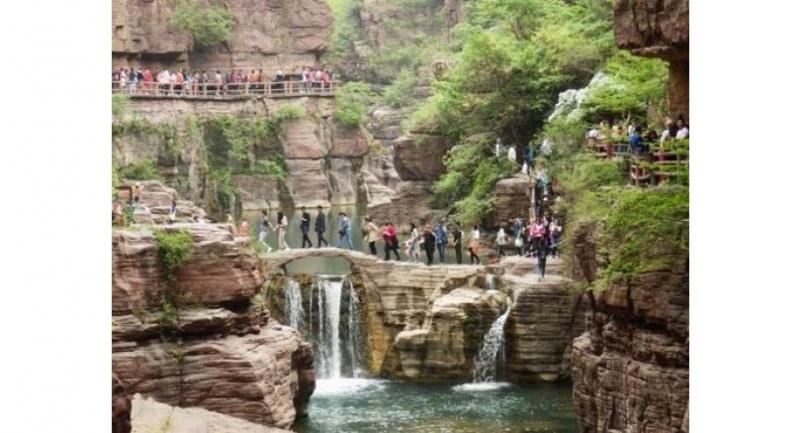Stairways to heaven

Dramatic rocks and fast-flowing water dominate the Yuntai Mountain Global Geopark
A recent trip to China’s Henan province where I was able to get up close and cosy with Lord Bao, the generals of the Yang family and the Shaolin Temple, ends with a visit to Yuntai Mountain Global Geopark in Jiaozuo. Named a geopark by Unesco in 2004, it is classified as a national 5A grade tourist attraction by the China National Tourism Administration.
Everything about Yuntai is big, even the entrance. We navigate our way through the electronic admission ticket system and board one of the sightseeing buses laid on for visitors.
Covered with verdant virgin forest, the geopark is famous for its mountain and water scenery. It’s divided into five unique scenic areas, all of them tourist attractions, namely the hanging springs and waterfalls of the Yuntaishan area, the gorges and mountain streams of the Qinglongxia area, the towering rock walls of the Fenglinxia area, the crystal clear waters of the Qingtianhe River, and the Dragon Crest Ridge of the Shennongshan Mountain.

A year-round destination, the scenery varies with the seasons. In spring, the mountain is decorated by wild flowers and green grass. In summer, the virgin forests and beautiful waterfalls make it an excellent resort. In autumn, leaves turn fiery red and the mountain looks like a colourful coat. In winter, snow turns the mountain into a white world of icy waterfalls, ice pillars and evergreen plants covered with snow.
“If you want to see all the hotspots, you need to stay for 3 or 4 days. You will be well catered for by the hotels and restaurants. As we have limited time, we will go the Red Stone Gorge, which features a waterfall and a lake. First we have to go down to the gorge and cross a stone bridge then walk along the lake until we arrive at the waterfall,” says our Thai-speaking Chinese guide.

The sightseeing bus drops us and other tourists at Hongshi Valley and we walk up to an inscribed stone before passing through the second entrance where we stop, stunned by the panorama unfolding in front of us. We have a full day to enjoy this first stop, which is the centrepiece of the geopark. The literature tells us that Red Stone is a linear gorge formed by red quartz sandstone deposited under the geology structure about 1.4 billion years ago. The strong uplift of a neotectonic movement and deep incisions made by water erosion gave rise to a sandstone cliff more than 50 metres high and a gorge that’s more than 1,500 metres long, 100 metres deep but only tens of metres wide.
We walk slowly down on the road before following a narrow ledge on the edge of the mountains. Crickets chirp loudly at the interruption of their morning nap and we stop occasionally to read the signs informing us about various interesting spots.

The first of these dwells on the red quartz sandstone that forms Red Stone Gorge. The redness, it reads, is the result of the oxidation of the element iron that occurs inside the rocks. An uneven distribution of the element iron among the rocks has led to a diversity in shades and the formation of beautiful patterns.
Another sign points us to the Happy Channel, which was built 17 years ago to solve the drinking and irrigation problems on Yuntai Mountain and its surrounding area. The Red Danxia cliff is one of the most imposing landscapes on Yuntai Mountain, formed some 1.2 billion years ago in purplish red quartz sandstone. Due to the faulting and weathering during the formation of Taihang Mountain, the rocks surfaced into the gorge and cliff, rather as if nature had skilfully carved a sunroof on Yuntai Mountain.
A small pathway on the edge of the mountains has been carefully constructed to allow visitors to walk through the inside and the outside of the mountain while bridges allows them to pass from one mountain to another. There’s water everywhere and it’s clear and green.

“China has four Great Beauties,” says the guide. “Xi Shi was said to be so entrancingly beautiful that fish would forget how to swim and sink below the surface upon seeing her reflection in the water. Wang Zhaojun was said to be so beautiful that her appearance would entice birds in flight to fall from the sky. Diaochan was said to be so luminously lovely that the moon itself would shy away in embarrassment when compared to her face. Unlike the other Beauties, there is no evidence she actually existed historically. Yang Guifei was said to have a face that made all peony flowers wither.”
As has inevitably been the case during our tip, the tourist attraction is swimming with Chinese tourists. Most of them don’t even pay lip service to the courtesies of sightseeing so I am both surprised and delighted when an old Chinese woman, a local tourist taking her friends’ picture along a narrow path, smiles and thanks me for stopping to let her take the picture in peace. We carry on walking and soon reach Shoulong Waterfall, another awe-inspiring sight with stones and towering cliffs facing each other as torrents scour a gully down the cliffs.
It’s time for us to catch the sightseeing bus again for our return journey. It’s been a wonderful experience and I’m only sorry we didn’t have time to go to Cornel Peak, the highest peak of Yuntai Mountain and take a stroll along its much-touted glass walkway suspended more than 1,000 metres above the ground.
The writer’s trip was sponsored by Thai Smile Airways.

IF YOU GO
Thai Smile Airways flies from Suvarnabhumi Airport in Bangkok to Zhengzhou, the capital of Henan province, on Wednesdays, Fridays and Sundays. Flight WE680 departs Suvaanabhumi at 2.20pm and arrives in Zhengzhou at 7.30pm. The return flight WE681 leaves Zhengzhou at 8.30am and lands at Suvarnabhumi at 11.40am.
Book your flight at www.ThaiSmileAir.com





